|
|
 |
PISTON FLUTE
ONCE UPON A TIME...
There are several different kinds of flute. Perhaps the best known of these is the recorder. The various holes along the tube determine what the notes will be when you blow into the mouth. The PISTON FLUTE, however, has no holes to provide the different notes. Instead, thereís a piston which moves up and down inside the tube and helps to produce a series of notes that are said not to be tempered. This means that in addition to the main notes (doh, ray, mi, fah, sol, lah, ti, doh and the ďaccidentalsĒ of 5 of these - i.e. the black keys on the piano - making a total of 12 notes), you can obtain yet more sounds. For example, if you make a rapid movement with the piston, you can imitate the chirp of a bird. If you have any budgerigars or canaries at home, try playing this flute in their vicinity. I donít believe that you actually know how to bird language, yet youíll certainly hear a reply to the sound of your PISTON FLUTE.
MATERIAL NEEDED
A plastic tube (PVC, 20 cm in diameter) and a small wooden pole.
TOOLS AND ACCESSORIES
A dovetail saw, a penknife, some sandpaper (Nļ. 150) and some glue.
HOW TO MAKE THE INSTRUMENT
So that you can make a good flute, itís important to make sure that the wooden pole fits tightly inside the plastic tube. This detail will be important when you come to make the hp of the instrument. About 2 cm from one of the ends, make an incision in the tube. About 1 cm further on, this time with the saw sloping at an angle, make a second cut in order to open the wind way for the hp of the flute. Donít press too hard when youíre sawing. The more pressure you make, the less you actually cut. So that you can carry out this operation carefully and successfully, you should clamp the tube in a vice and hold the saw correctly. Be very careful with your fingers and, remember, thereís no need to hurry. Use the penknife to make sure that the wind way is just right, removing the little bits of plastic that are always left behind after sawing a tube. Youíre going to use the wooden pole or a small cork to make the plug. This is the bit that youíll then place inside the tube. Itís roughly 2 cm long and runs from one end to the beginning of the wind way. Make an incision in the round part with your penknife to let the air through when you blow. The plug must be stuck inside the tube. Once itís nice and dry, use the saw to cut a slope on the part opposite the wind way and then smooth this down with the sandpaper. The wooden pole can be replaced with an old pen, as long as you stick some sellotape at one end to make it thicker so that it will then fit snugly inside the tube.
DECORATION
What do you normally do with your wrapping paper after youíve opened your presents? 1 used to use mine to cover my school books. If youíve got any stored away somewhere, you can cut off some strips and wrap them round the tube. As always, this is just a suggestion. They say that thereís no point in discussing tastes... although 1 disagree with this statement.
HOW TO PLAY THE INSTRUMENT
The technique that you should use to play the flute is as follows: try to blow while saying ďtooĒ at the same time. As you move the piston, youíll obtain a sequence of musical notes. The further down the tube it goes, the higher the note. Normally grown-ups donít find these conversations with birds very funny. Donít worry, however, when youíre a grown-up, youíll inevitably react the same way. They say itís got something to do with the generation gap. Keep on playing and having fun for as long as you can. Thereís no point in growing old before your time.
